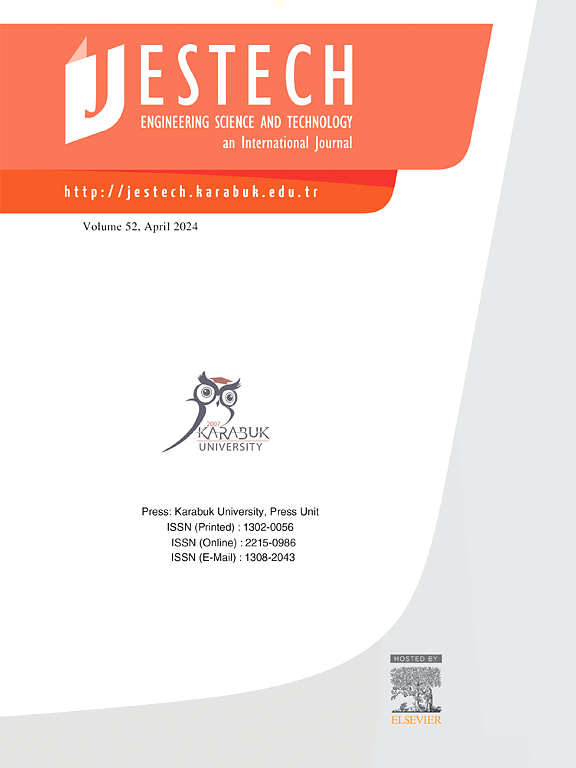Increasing integration of wind energy through the joint operation of electric vehicles and the grid using the intelligent spider monkey algorithm
IF 5.4
2区 工程技术
Q1 ENGINEERING, MULTIDISCIPLINARY
Engineering Science and Technology-An International Journal-Jestech
Pub Date : 2025-02-28
DOI:10.1016/j.jestch.2025.102017
引用次数: 0
Abstract
This study introduces an advanced framework to enhance the integration of wind energy into power systems by utilizing electric vehicles (EVs) as dynamic energy storage units through vehicle-to-grid (V2G) technology. The proposed cooperative model integrates EV aggregators with wind power systems, operating under a single commitment approach with security constraints. Unlike existing studies, this framework incorporates detailed modeling of EV aggregation, accounting for diverse user travel patterns, time-varying energy storage capacities, and the complexities of charging and discharging behaviors. A significant innovation involves demonstrating that prohibitive constraints on simultaneous charging and discharging can, under specific conditions, be relaxed without compromising system stability, thereby simplifying the optimization process. The optimization problem is formulated as a single objective problem and solved using an improved spider monkey optimization algorithm. This algorithm delivers robust convergence, computational efficiency, and highly accurate solutions to complex energy dispatch problems. The framework is validated through extensive case studies on the IEEE system, incorporating realistic wind energy profiles and EV penetration scenarios. The research demonstrates a 28 % improvement in wind energy absorption, a 15 % reduction in thermal unit operating costs, and a substantial mitigation of storage violations under dynamic conditions. Furthermore, the study highlights the role of V2G in balancing renewable energy variability and reducing peak load pressures, showcasing its potential to optimize grid operations and improve reliability.
利用智能蜘蛛猴算法,通过电动汽车和电网的联合运行,增加风能的整合
本研究介绍了一个先进的框架,通过车辆到电网(V2G)技术,利用电动汽车(ev)作为动态储能单元,加强风能与电力系统的整合。提出的合作模型将电动汽车聚合器与风力发电系统集成在一起,在具有安全约束的单一承诺方式下运行。与现有研究不同,该框架结合了电动汽车聚集的详细建模,考虑了不同的用户出行模式、时变的储能容量以及充放电行为的复杂性。一项重要的创新涉及证明,在特定条件下,可以在不影响系统稳定性的情况下放松对同时充放电的限制性限制,从而简化优化过程。将优化问题表述为单目标问题,并采用改进的蜘蛛猴优化算法求解。该算法为复杂的能源调度问题提供了强大的收敛性、计算效率和高度精确的解决方案。通过对IEEE系统的广泛案例研究,结合现实的风能概况和电动汽车渗透场景,验证了该框架。该研究表明,风能吸收量提高了28%,热电机组运行成本降低了15%,并大大缓解了动态条件下的存储违规问题。此外,该研究还强调了V2G在平衡可再生能源可变性和降低峰值负荷压力方面的作用,展示了其优化电网运行和提高可靠性的潜力。
本文章由计算机程序翻译,如有差异,请以英文原文为准。
求助全文
约1分钟内获得全文
求助全文
来源期刊

Engineering Science and Technology-An International Journal-Jestech
Materials Science-Electronic, Optical and Magnetic Materials
CiteScore
11.20
自引率
3.50%
发文量
153
审稿时长
22 days
期刊介绍:
Engineering Science and Technology, an International Journal (JESTECH) (formerly Technology), a peer-reviewed quarterly engineering journal, publishes both theoretical and experimental high quality papers of permanent interest, not previously published in journals, in the field of engineering and applied science which aims to promote the theory and practice of technology and engineering. In addition to peer-reviewed original research papers, the Editorial Board welcomes original research reports, state-of-the-art reviews and communications in the broadly defined field of engineering science and technology.
The scope of JESTECH includes a wide spectrum of subjects including:
-Electrical/Electronics and Computer Engineering (Biomedical Engineering and Instrumentation; Coding, Cryptography, and Information Protection; Communications, Networks, Mobile Computing and Distributed Systems; Compilers and Operating Systems; Computer Architecture, Parallel Processing, and Dependability; Computer Vision and Robotics; Control Theory; Electromagnetic Waves, Microwave Techniques and Antennas; Embedded Systems; Integrated Circuits, VLSI Design, Testing, and CAD; Microelectromechanical Systems; Microelectronics, and Electronic Devices and Circuits; Power, Energy and Energy Conversion Systems; Signal, Image, and Speech Processing)
-Mechanical and Civil Engineering (Automotive Technologies; Biomechanics; Construction Materials; Design and Manufacturing; Dynamics and Control; Energy Generation, Utilization, Conversion, and Storage; Fluid Mechanics and Hydraulics; Heat and Mass Transfer; Micro-Nano Sciences; Renewable and Sustainable Energy Technologies; Robotics and Mechatronics; Solid Mechanics and Structure; Thermal Sciences)
-Metallurgical and Materials Engineering (Advanced Materials Science; Biomaterials; Ceramic and Inorgnanic Materials; Electronic-Magnetic Materials; Energy and Environment; Materials Characterizastion; Metallurgy; Polymers and Nanocomposites)
 求助内容:
求助内容: 应助结果提醒方式:
应助结果提醒方式:


